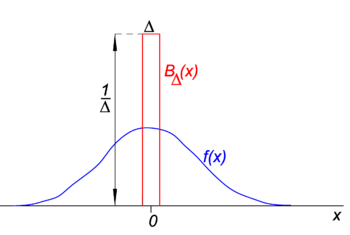Dirac delta function: Difference between revisions
imported>Paul Wormer No edit summary |
imported>Paul Wormer |
||
| Line 65: | Line 65: | ||
'''Note''': We integrated over the whole real axis. Obviously this is not necessary, we could have integrated from −Δ/2 to +Δ/2. In mathematical texts, as e.g. Ref. <ref>I. M. Gel'fand and G. E. Shilov, ''Generalized Functions'', vol. 1, Academic Press, New York (1964). Translated from the Russian by E. Saletan.</ref>, this refinement in the integration limits is usually included in the definition of the delta-convergent sequence. Because for most of the delta-convergent sequences encountered in physical applications, the integration over the whole real axis is without problems and does not give an extra constraint, we do not attempt to give the more refined mathematical definition. | '''Note''': We integrated over the whole real axis. Obviously this is not necessary, we could have integrated from −Δ/2 to +Δ/2. In mathematical texts, as e.g. Ref. <ref>I. M. Gel'fand and G. E. Shilov, ''Generalized Functions'', vol. 1, Academic Press, New York (1964). Translated from the Russian by E. Saletan.</ref>, this refinement in the integration limits is usually included in the definition of the delta-convergent sequence. Because for most of the delta-convergent sequences encountered in physical applications, the integration over the whole real axis is without problems and does not give an extra constraint, we do not attempt to give the more refined mathematical definition. | ||
===Gaussian functions=== | |||
[[Image:Gauss functions for three different parameters.png|thumb|left|350px|Fig. 2. Gaussian functions.]] | |||
Consider the family, | |||
:<math> | |||
F_\alpha = \frac{1}{2\sqrt{\pi\alpha}} e^{-x^2/(4\alpha)}\quad\hbox{with}\quad | |||
\int_{-\infty}^\infty F_\alpha(x)\mathrm{d} x = 1. | |||
</math> | |||
As is shown in Fig. 2 the functions peak around ''x'' = 0 and become narrow for decreasing α. Hence the family of Gaussian functions forms a delta-convergent sequence. | |||
==References== | ==References== | ||
<references /> | <references /> | ||
Revision as of 12:49, 21 December 2008
In physics, the Dirac delta function is a function introduced by P.A.M. Dirac in his seminal 1930 book on quantum mechanics.[1] Heuristically, the function can be seen as an extension of the Kronecker delta from discrete to continuous indices. The Kronecker delta acts as a "filter" in a summation:
Similarly, the Dirac delta function δ(x−a) may be defined by (replace i by x and the summation over i by an integration over x),
The Dirac delta function is not an ordinary well-behaved map , but a distribution, also known as an improper or generalized function. Physicists express its special character by stating that the Dirac delta function makes only sense as a factor in an integrand. Mathematicians say that the delta function is a linear functional on a space of test functions.
Properties
Most commonly one takes the lower and the upper bound in the definition of the delta function equal to and , respectively. From here on this is assumed.
The physicist's proof of these properties proceeds by making proper substitutions into the integral and using the ordinary rules of integral calculus.
Delta-convergent sequences
There exist families of regular functions of which the family members differ by the value of a single parameter α. An example is the family of Gauss functions Fα(x) = exp(−αx²), where the different values of the single parameter α distinguish the different members. When furthermore all members are linearly normalizable, i.e.,
irrespective of α, and all members peak around x = 0, then the family may form a delta-convergent sequence.
Consider as a simple example the family of block functions, characterized by positive Δ,
In Fig. 1 the block function is shown in red. Evidently, the area (width times height) under the red curve is equal to unity, irrespective of the value of Δ,
Let the arbitrary function f(x) (blue in Fig. 1) be continuous (no jumps) and finite in the neighborhood of x=0. When Δ becomes very small, and the block function very narrow (and necessarily very high because width times height are constant) the product f(x) BΔ(x) becomes in good approximation equal to f(0) BΔ(x). The narrower the block the better the approximation. Hence for Δ going to zero,
which may be compared with the definition of the delta function,
It follows that the family of block functions converges to the Dirac delta function for decreasing parameter Δ; the family forms a delta-convergent sequence.
Note: We integrated over the whole real axis. Obviously this is not necessary, we could have integrated from −Δ/2 to +Δ/2. In mathematical texts, as e.g. Ref. [2], this refinement in the integration limits is usually included in the definition of the delta-convergent sequence. Because for most of the delta-convergent sequences encountered in physical applications, the integration over the whole real axis is without problems and does not give an extra constraint, we do not attempt to give the more refined mathematical definition.
Gaussian functions
Consider the family,
As is shown in Fig. 2 the functions peak around x = 0 and become narrow for decreasing α. Hence the family of Gaussian functions forms a delta-convergent sequence.
![{\displaystyle \sum _{i=1}^{n}f_{i}\delta _{ia}={\begin{cases}f_{a}&\quad {\hbox{if}}\quad a\in [1,n]\subset \mathbb {N} \\0&\quad {\hbox{if}}\quad a\notin [1,n].\end{cases}}}](https://wikimedia.org/api/rest_v1/media/math/render/svg/075d2d9d2603b18a348288b43bf11b01df528af0)
![{\displaystyle \int _{a_{0}}^{a_{1}}f(x)\delta (x-a)\mathrm {d} x={\begin{cases}f(a)&\quad {\hbox{if}}\quad a\in [a_{0},a_{n}]\subset \mathbb {R} ,\\0&\quad {\hbox{if}}\quad a\notin [a_{0},a_{n}].\end{cases}}}](https://wikimedia.org/api/rest_v1/media/math/render/svg/e5618407c7eba0833e0c5fe5d2198b0ab09fa234)











